Sciatica is a pain in the ass. And the spine. And the legs. It can come as a result of many different issues/injuries, and preventing them is your best bet for keeping the pain at arms-length. What’s a great way to prevent sciatica? By stretching, of course!
But not just any stretching – the right kind of stretching. These 14 sciatica exercises have our full backing.
A quick look at 14 stretches to prevent sciatica
- Scissor hamstring stretch
- Back flexion stretch
- Single knee-to-chest stretch
- Knee to opposite shoulder stretch
- Sciatic nerve glide
- Cobra pose
- Seated hip stretch
- Standing hamstring stretch
- Sitting spine twist
- Reclining pigeon pose
- Sitting pigeon pose
- Foreward pigeon pose
- Groin and long adductor stretch
- Standing piriformis stretch

Breaking down 14 of the best stretches for preventing sciatica pain
These 14 sciatic nerve exercises are our favorites for relieving tension and pain.
1: Scissor hamstring stretch
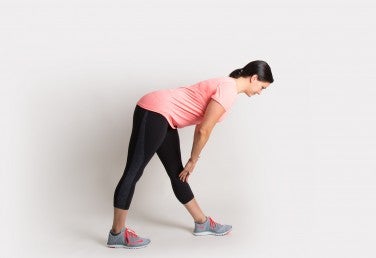
This nice, easy intro to sciatica stretching eases your hamstrings. If they’re too tight, they’ll pull on your pelvis and stress your lower back. To address this, performing scissor hamstring stretches every day can reduce stress in the lower back.
How to do it:
- Begin by standing with your right foot aligned roughly three feet in front of your left.
- Keep your hips and shoulders square, put your hands on your hips if it helps.
- Bending forwards at the waist with a straight back, align your torso above your front foot.
- With your weight mostly supported on your front leg, hold this pose for 10 seconds.
- Return to the starting position and repeat, this time with your left foot in front of your right.
- Aim for three reps per leg.
2: Back flexion stretch
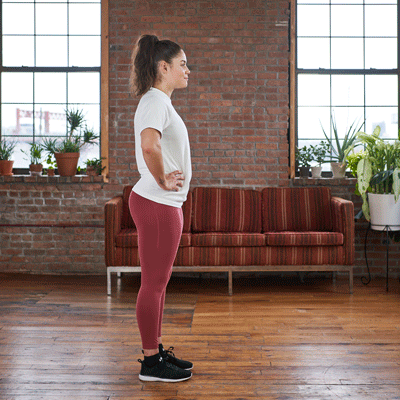
With plenty of variations, this stretch can be done either standing or sitting. When done correctly, you’re helping to ease pain with your back’s flexion (when the spine bends forwards).
How to do it:
- Start by standing straight, feet about hip-width apart.
- While keeping your legs straight, bend forward at the waist and bring you head down as far as you can.
- Once you start to feel the stretch in your lower back, ease into it, placing your hands on your ankles or the floor for support.
- Hold for 10 seconds before easing back to the start position
- Aim for three reps
3: Single knee-to-chest stretch
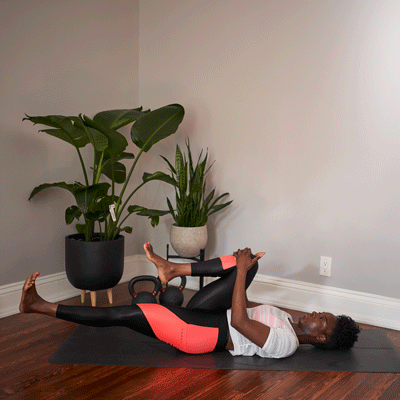
The single-leg knee-to-chest stretch is an isolation exercise, meaning it works one side of your body at a time. That’s good for evening up any muscle imbalances and keeping your weight spread evenly.
How to do it:
- Lie on your back and grip beneath your right knee with your right hand.
- Gently pull your right leg up to your chest until you feel a cosy stretch in your hip.
- Hold for 10 seconds.
- Ease back to the starting position and repeat with your left leg.
- Aim for three reps.
4: Knee to opposite shoulder stretch
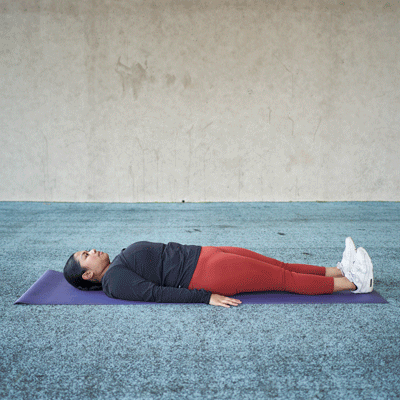
A harder variant of the single-knee stretch, this deeper stretch helps with spinal flexion and opens up plenty of room for the nerve.
How to do it:
- Lie on the floor with your legs together, fully extended.
- Bring your right knee up and grip the top of it with both hands.
- Without lifting your hips from the floor, bring your right knee up towards your left shoulder.
- Once you feel a comfortable stretch, bring your head up to complete the move.
- Hold for 30 seconds before returning to the start position.
- Repeat with your left knee, aim for three reps on each leg.
5: Seated sciatic nerve glide
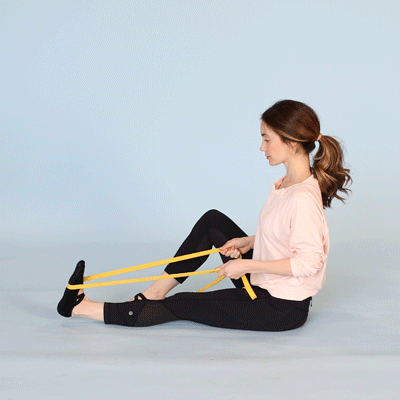
This seated exercise is great for increasing ankle mobility. It also desensitizes your sciatic nerve, improving range of motion in your legs. It works one leg at a time, helping you address any imbalances between muscles.
How to do it:
- Start by sitting in a chair or on the floor with your back straight.
- Keep one knee bent so that the foot is flat against the floor, while straightening the other knee so that the other foot is in front of you.
- Bend your foot back so your toes are pointing at you. You can use a resistance band or towel to help pull your toes back if needed.
- Bend that foot back the other way so the toes are pointing away from you.
- Flex your foot back and forth 20 times. If you want to make it harder, lean your head forward so the chin is resting on your chest.
- Repeat with your other leg, aim for one set of 20 reps.
6: Cobra pose
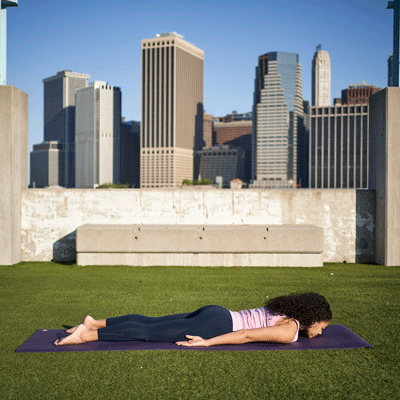
As well as being a good exercise with a badass name, the cobra pose can help alleviate symptoms caused by a herniated disc. It also has a modified version to make things easier.
How to do it:
- Lie on your stomach with your legs extended behind you.
- Bend your elbows so that your palms are flat against the floor by your chest.
- Lift your chest off the floor by straightening your elbows. If this hurts, modify it by only partially straightening the elbows, lifting your chest 45 degrees.
- Hold for 10 seconds and gently return back to the start position.
- Aim for 10 reps.
7: Seated hip stretch

The sitting-down version of the piriformis stretch (which we’ll get to later) is another great option for improving mobility in the hips and lower back. Obviously, you’ll need a chair or bench for this one.
How to do it:
- Sit with your feet flat against the floor, knees at 90 degrees.
- Raise your right leg and place its ankle on top of your left knee.
- Focus on your breathing while leaning your torso forwards over the ankle and knee.
- Hold for 30 seconds before returning to the start position.
- Repeat with your left leg, aim for three reps on each leg.
8: Standing hamstring stretch
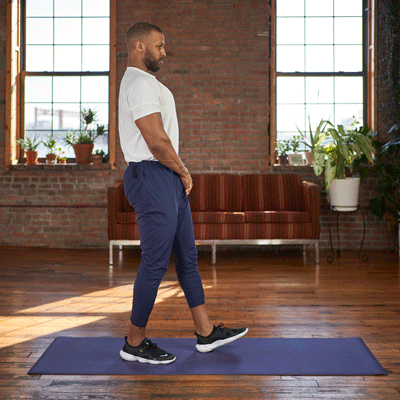
Going back to the hamstrings for a sec – they attach to the base of your pelvis and can cause lower back pain or tightness if they’re not limbered up. This stretch helps limber them up!
How to do it:
- Stand upright with your feet together.
- Extend your right leg out about five inches in front of you, resting the heel on the floor or a chair (anything that’s slightly below waist height).
- Lean forward from your waist, keeping your back straight until you feel the stretch in the back of your leg.
- Hold for 30 seconds before returning to the start position.
- Repeat with your left leg, aim for three reps on each leg.
9: Sitting spine twist
Here’s another nice, gentle flex to ease pressure on your joints.

How to do it:
- Start sat on the floor, back straight and your legs out in front of you.
- Place your right foot on the floor, crossed over the outside of your left knee.
- Twist your torso to the right, deepen the stretch by reaching your left elbow on the outside of your right knee.
- Hold this stretch for 20-30 seconds before returning to the start position.
- Repeat on your other leg, aim for three reps per leg.
10: Reclining pigeon pose
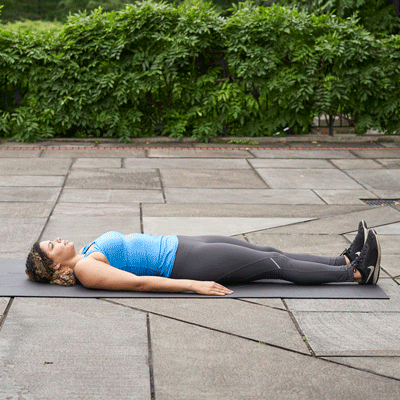
The hips can hold a lot of tension and cause sciatica pain. This, the first of our three pigeon pose variants, eases that tension.
How to do it:
- Lie flat on your back with your legs together against the floor.
- Lift and bend both your legs, bend your right knee 90 degrees and cross it over your left thigh.
- Grip behind your left thigh with both hands and pull into your body til you feel the limit of the stretch.
- Hold for 30 seconds before returning to the start position.
- Repeat with the other leg, aim for three reps.
11: Sitting pigeon pose
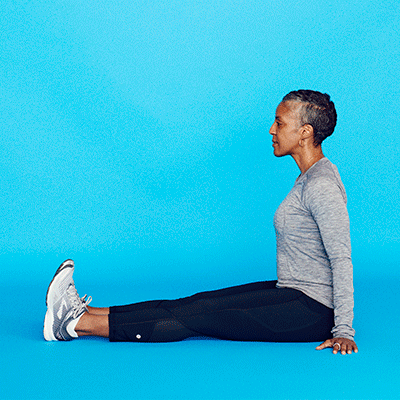
Sticking with the pigeon theme, these sciatica exercises all open up greater hip flexion and general mobility.
How to do it:
- Start by sitting on the floor, stretching both legs straight in front.
- Bend your right knee and place your ankle across your left knee.
- Lean forward so your upper body stretches towards your thigh.
- Hold for 30 seconds before returning to start position.
- Repeat with the other leg, aim for three reps.
12: Forward pigeon pose

The forward, or traditional pigeon pose is commonly the most difficult of the variations, but it’s an effective way to really stretch out your hips using your own body weight.
How to do it:
- Get down on your hands and knees.
- Move your right knee forward, lay it in front of your torso so that your right foot is aligned with your left knee against the floor.
- Move your left leg back until it’s against the floor, your body will naturally lower down onto your right leg.
- Supporting most of your weight with your legs, use your arms to lower your torso down until you feel the stretch in your right butt cheek (or glute, if we’re being technical).
- Hold for 30 seconds, then return to start.
- Repeat with the other leg, aim for three reps per leg.
13: Groin and adductor stretch
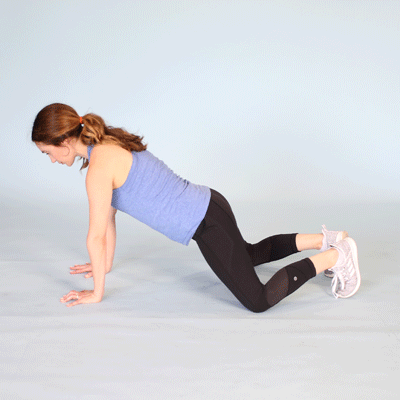
Tense groin or adductor muscles can quickly translate into sciatic nerve pain. Thankfully, keeping things nice and loose should be simple enough by doing this stretch.
How to do it:
- Start on all fours, with your knees spread wide as you can get them.
- Keeping your hands flat on the floor and elbows straight, rock your torso backward into your hips.
- Use your hands to push yourself back even further until you start to feel it in your groin area.
- Hold this position for 15 seconds.
- Ease back into the start position and repeat for three reps.
14: Standing piriformis stretch
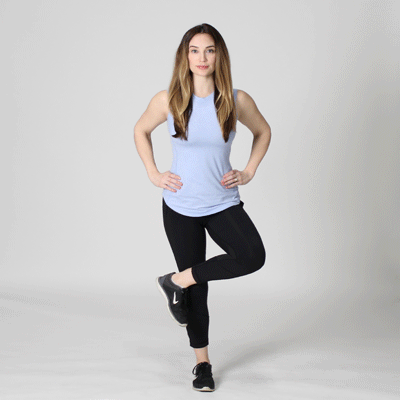
Let’s finish with a more challenging sciatica exercise. Your piriformis muscle lives in your butt, near the top of your hip joint. This stretch helps it relieve tension. If you can balance and do it free standing, that’s great. But if you need support, you can stand a meter or so away from a wall to start.
How to do it:
- Stand with feet at shoulder width.
- Cross your right leg over your left knee.
- Bend your right leg slightly til your hips are bent at 45 degrees.
- Hold for 15 seconds once your legs are in the characteristic number 4 shape.
- Ease back into the starting position and repeat with your other leg.
- Aim for three reps on each leg.
What’s the sciatic nerve and why does it hurt?
The sciatic nerve is the biggest nerve in your body, running from the base of your spine, through your butt, and right down each leg to your heels. When it gets irritated or inflamed, pain can flare up anywhere the nerve travels. This pain is called sciatica.
The nerve can get injured for all sorts of reasons, from herniated discs and infection to simply not stretching properly. If the pain wasn’t bad enough, limited nerve mobility can impair your legs’ range of motion.
Studies like this one state that taking the time to stretch out your lower body can ease pressure on the sciatic nerve and reduce the pain.
What are some alternative treatments for sciatica?
Stretches are great for preventing or relieving sciatic pain, but you’ve got other options too:
- For the first few days after you experience stiffness or pain, apply ice to the area three times daily.
- After those first few days, switch up and apply heat to the painful area instead.
- Anti-inflammatories like ibuprofen can help ease sciatic pain.
Talk to a medical professional if sciatica sticks around for more than a few weeks.
Conclusion: Feeling spine and dandy!
Sciatic pain can strike at any time in our lives. Perform these stretches daily, even when you’re not experiencing pain, to keep yourself limber and cut your risk of injury. After all, when it comes to your health, a penny of prevention is worth a dollar of cure.

0 Commentaires